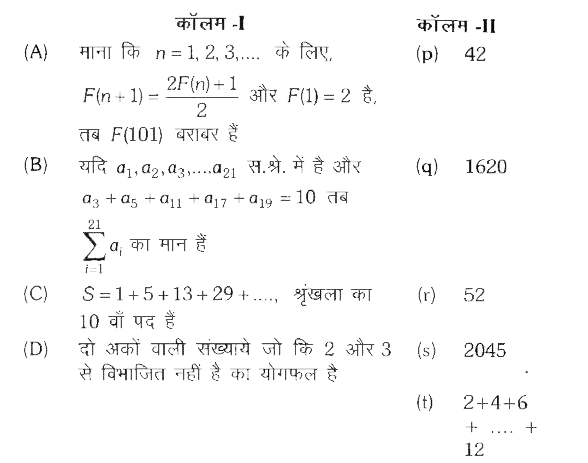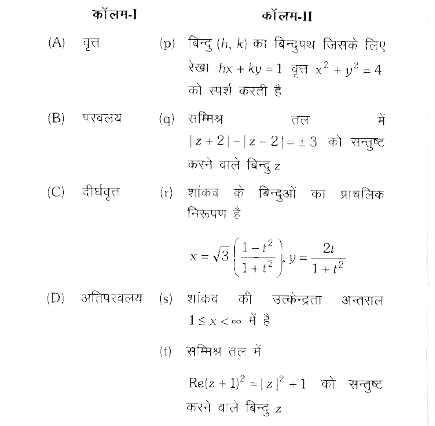माना एक समान्तर श्रेणी के पद है यदि तब बराबर है
The correct Answer is:D
Step by step video, text & image solution for माना a_1,a_2,a_3…..एक समान्तर श्रेणी के पद है यदि (a_1+a_2+….+a_p)/(a_1+a_2+…..+a_q)=p^2/q^2, p ne qतब a_6/a_21 बराबर है by Maths experts to help you in doubts & scoring excellent marks in Class 12 exams.
Topper's Solved these Questions
- BOOK - ERRORLESS HINDICHAPTER - श्रेणियाँ EXERCISE - SOLVED MULTIPLE CHOICE QUESTIONS (गुणोत्तर श्रेणी)34videos
श्रेणियाँ
- BOOK - ERRORLESS HINDICHAPTER - श्रेणियाँ EXERCISE - SOLVED MULTIPLE CHOICE QUESTIONS (हरात्मक श्रेणी)6videos
श्रेणियाँ
- BOOK - ERRORLESS HINDICHAPTER - श्रेणियाँ EXERCISE - JEE ADVANCED (MATRIX MATCH TYPE QUESTIONS)1videos
श्रेणियाँ
- BOOK - ERRORLESS HINDICHAPTER - शांकव परिच्छेद EXERCISE - JEE Advanced (Matrix Match type questions)7videos
शांकव परिच्छेद
- BOOK - ERRORLESS HINDICHAPTER - सदिश बीजगणित EXERCISE - JEE Advanced (Matrix Match type questions)7videos
सदिश बीजगणित
Similar Questions
यदि गुणोत्तर श्रेणी का चौथा सातवा और दसवा पद करमस a b c हो तो a b c सम्बन्ध होगा
02:35View Solution13 15 19 में क्या जोड़े की योग से प्राप्त पद हरात्मक श्रेणी के कर्मगत पद है
04:52View Solutionनिम्नलिखित कॉलम I को कॉलम II से मिलाये
 06:38View Solution
06:38View Solution 05:05View Solution
05:05View Solution 05:38View Solution
05:38View SolutionEvaluate: △∣∣ ∣∣1+a1a2a3a11+a2a3a1a21+a3∣∣ ∣∣
04:40View SolutionIf p(x),q(x)andr(x) be polynomials of degree one and a1,a2,a3 be real numbers then ∣∣ ∣ ∣∣p(a1)p(a2)p(a3)q(a1)q(a2)q(a3)r(a1)r(a2)r(a3)∣∣ ∣ ∣∣= (A) 0 (B) 1 (C) -1 (D) none of these
02:06View SolutionLet a1,a2,a3………. be term of an A.P. if a1+a2+….+apa1+a2+………+aq=p2q2p≠q then a6a21 euqals (A)4111(B)1141(C)1344(D)1541
02:36View SolutionLet a1,a2,a3 …..be in A.P. and ap,aq,ar be in G.P. Then aq:ap is equal to :
06:45View SolutionIf a1,a2,a3, be terms of an A.P. and a1+a2+.....+apa1+a2+.....+aq=p2q2,p≠q,thena6a21 equals to (a).41/11 (b). 7/2 (c). 2/7 (d). 11/41
04:49View SolutionConsider an A.P.a1,a2,a3,..... such that a3+a5+a8=11anda4+a2=−2 then the value of a1+a6+a7 is.....
07:22View SolutionFor any two events A1 and A2, show that P(A1∩A2)≤min{P(A1),P(A2)} where min{P(A1),P(A2)} is the minimum of P(A1) and P(A2).
05:59View SolutionIf A1, A2, A3 are mutually exclusive and exhaustive, then P(A1)+P(A2)+P(A3) equal______
03:22View SolutionLet a1,a2,a3,.... be terms of an A.P. if a1+a2+....+apa1+a2+...+aq=p2q2.p≠q then a6a21 equals
04:21View SolutionLet a1,a2,a3 …..be in A.P. and ap,aq,ar be in G.P. Then aq:ap is equal to :
16:52View Solution

